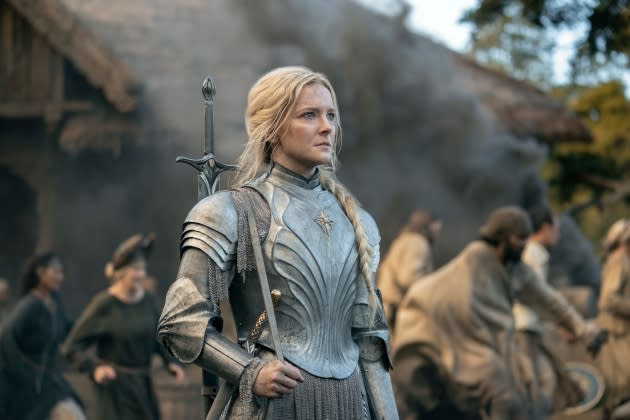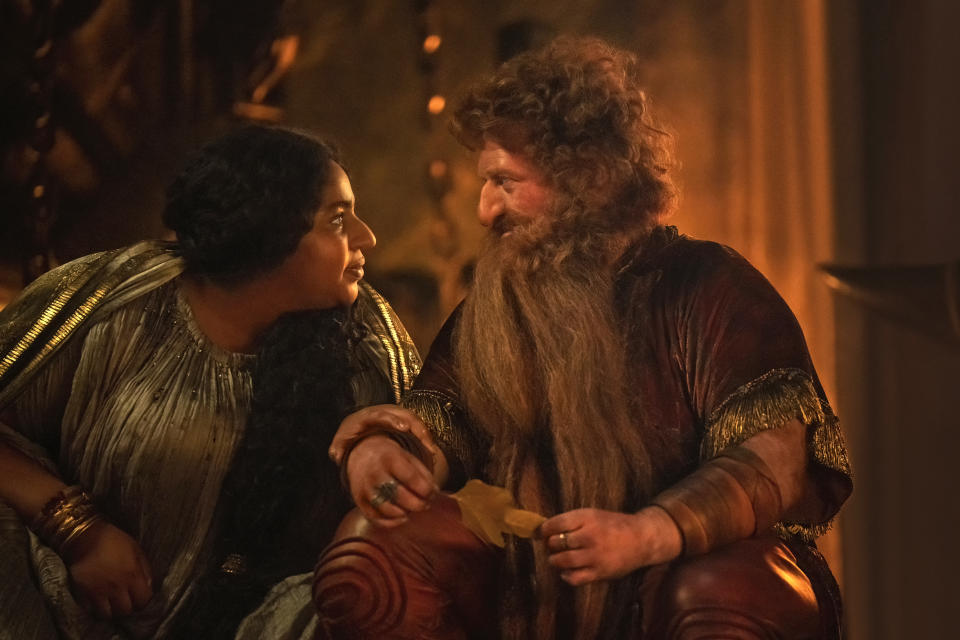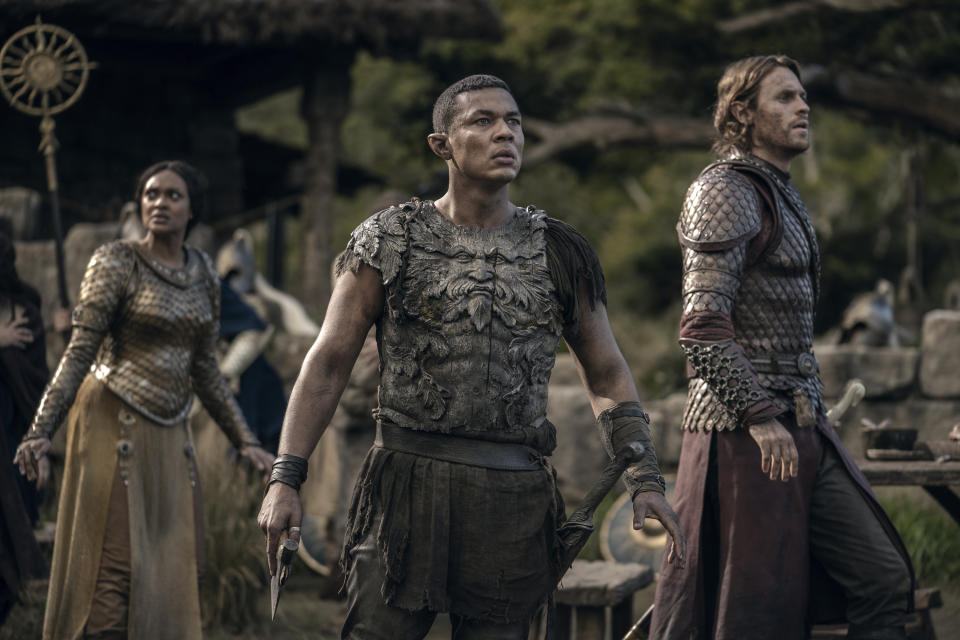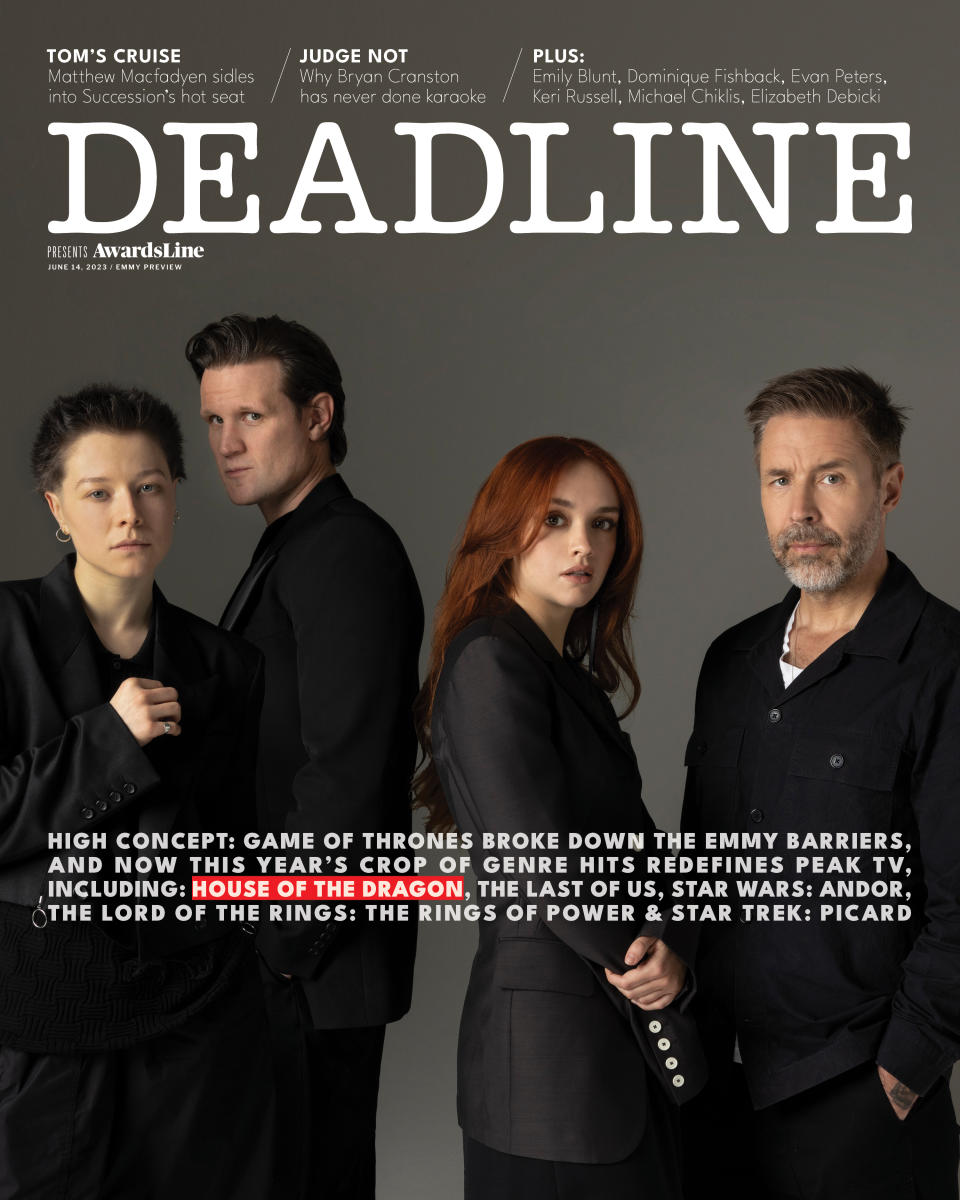‘The Lord Of The Rings: The Rings Of Power’ Creators Break The Bank To Bring A New Reality To The Fantasy Genre
- Oops!Something went wrong.Please try again later.
- Oops!Something went wrong.Please try again later.
- Oops!Something went wrong.Please try again later.
- Oops!Something went wrong.Please try again later.

Fantasy on TV was once the preserve of teen-skewing shows like Xena and Hercules, until Game of Thrones made things bigger but bloodier with its blockbuster eight-year run. Now, however, the genre is expanding in unexpected ways, typified by Amazon’s The Lord of The Rings: The Rings of Power. Where we might have expected another adaptation about obviously good folk fighting clear evil, the show that emerged offers a look at power, obsession and conflict set thousands of years before J.R.R. Tolkien’s foundational text. After Thrones (and its own prequel), it is a coming-of-age for the genre, proof that fantasy is capable of offering subtlety and complexity as well as large-scale adventure.
The TV spin-off from the most influential fantasy book of all time might have gone any number of ways: there were rumors of a new adaptation of Frodo’s story or a straightforward prequel about a young Aragorn. But the show that emerged, from showrunners Patrick McKay and John D. Payne, is a stranger and more morally compromised beast, drawn from the appendices to Tolkien’s richly detailed text and hinted-at histories to some of its peripheral characters.
More from Deadline
Chief among those is Galadriel, once played with stately reserve by Cate Blanchett in Peter Jackson’s films but now brought to younger and more fiery life by Morfydd Clark, the gifted young Welsh star of Saint Maud. Secrecy around the show was so tight that Clark didn’t know what show she was auditioning for until she was in the room — and didn’t know her role until she reached New Zealand, where Season 1 was shot. “I had to have a word with myself, and redo everything in my head that I had thought of,” she says. “Looking back, it was a crazy thing to do, to fly to the other side of the world without knowing anything. It felt like I got on a rollercoaster and just kept going. I don’t think it was until I got into my costume on set that it really hit. Your imagination can only go so far.”
Imagination was key because the scale of The Rings of Power is unprecedented. Famously, it is the most expensive TV show ever made, with Amazon paying a reported $250 million to the Tolkien estate just for the rights. Prior to release there was an attempt to portray it as a sort of Bezos folly, with a source describing the rights deal as “insane”. That initial outlay, after all, had to be followed by lavish costumes, huge sets and a full complement of dwarves and orcs, by some accounts doubling its cost.

“When I heard all that stuff about numbers I thought, ‘Isn’t it amazing that so much has been put into a piece of art?’” says Clark. “You did feel that when you were there. You could be completely transformed, see nothing but set. The orcs and the background actors are such a massive part of it. I’ve never felt more like [acting] is not an individual pursuit.”
The sprawling story of the show takes in numerous races and their competing politics, but at its heart stands Galadriel and her conviction that the elves’ ancient enemy, Sauron, has survived his apparent defeat centuries before and will return if not found and destroyed for good. As she seeks him out, the presence of certain suspicious strangers and growing tensions between the dwarves, elves, humans and hobbit-like ‘Harfoots’ suggest that Sauron’s influence is not only alive but growing across Middle Earth.
Such a plot required vivid, layered characters of all sizes, which inevitably brought challenges for its cast. The dwarves labored to communicate emotion through thick beards and bushy wigs, while the elves had to leave behind human weakness and avoid any impulse to slouch in order to embody the grace of millennia (“You never feel more human than when you fall over while playing an elf,” laughs Clark). For the cast, creating such non-human roles requires more of actors, not less.
“Fantasy pushes you to elevate your craft,” says Sophia Nomvete, who plays the garrulous dwarf princess Disa. “There is a theatricality about it; everything has to extend that little bit further because you’re working hard through these costumes and prosthetics to match a story and a performance. That’s what’s exciting about the craft for actors working with fantasy. It’s unreal that it’s not noticed or given the credit it deserves, because every single department is working in such a tough and more elevated place. Creativity at its highest form, I think.”
Her onscreen husband Durin, aka Welsh actor Owain Arthur, concurs. “It feels like theater. I remember coming off the day’s work buzzing with adrenalin. And I’ve never had that on TV or film before, only on stage.” Arthur, who comes from a mining part of Wales, connected immediately to the dwarfs’ Celtic energy and underdog indefatigability, and if he lost his battle to give them all Welsh accents, grew to enjoy their Scottish tones instead.
He even grew fond of his prosthetic nose and itchy beard. “I’d never worked with prosthetics before, so I was excited. But I quickly realized how challenging it was going to be. With all of this stuff on, it is a hindrance. You try to focus on your intentions, but you have to make these things work for you. So, it took a while. But still, today, I’m humbled. I consider myself very lucky to go in and play a different being every day, to stretch how far you can go from being a human.”

For the largely unknown cast, that vast budget was most felt in those expert prosthetics and in that sense of detail and depth created by the show’s talented crew. They had Kate Hawley costumes in natural materials, rich with details that no camera would ever catch; elements of the various races’ histories carved into the sets and props around them. Hawley created an ‘inspiration room’, with a corner for each race and samples of materials, examples of key colours and design motifs and sketches of their typical looks.
“I remember seeing someone making the lichen on the rocks,” marvels Ismael Cruz Córdova, who plays the forest elf foot soldier Arondir. “I thought they were real, and I grew up in the mountains! It was that level of detail; there’s mythology in each of the sets for each world. What it does to you as an actor, even when you don’t perceive it, is it infuses your work.”
Puerto Rican actor Cruz Córdova saw the Peter Jackson Lord of The Rings films as a child and got his introduction to the craft of filmmaking when he saved his pocket money to buy the DVDs and devoured the ‘making of’ featurettes. “I fought tooth and nail for the role. Fantasy, growing up, did give me magic. I always wanted to be an elf. It inspired me to go into filmmaking, because of the bonus features on Lord of the Rings. In my mind, I have always been on the fringe and so is Arondir, so I really believed in this role. Genre is overlooked because I don’t think people know how much goes into preparing for these roles, what it requires of an actor. It’s very removed from anything we can pull from life.”
He too only learned which part he was playing, and that his lifelong dream of elf-hood was about to come true, the night before his final audition in New Zealand. He recalls going to a local park and trying to improvise among the trees, apologizing to and praying for a tree before resolving to cut it down. That moment, repeated in his audition, made it to an episode of the show. Nor is he alone in contributing ideas to McKay and Payne’s vision of Middle Earth.
“They were so inspiring,” says Arthur of the showrunners. “John and Patrick were my gateway into this world. Just watching both of them being so excited about what they were creating was intoxicating. I felt that I had the right to contribute to that level of excitement like, what about this? What about this? There’s stuff that happens in Season 2 that I think came from a conversation we had together. It’s wonderful to have such receptive showrunners.”
It’s proof that even a half-billion-dollar behemoth can allow for individual creative input. Of course, in the end much of the show’s massive cost was due to Covid delays. The pandemic hit just as the cast began to arrive in New Zealand. Even though the country locked down its borders but not its people, the internationally-based cast still had to endure quarantine if they traveled to or from New Zealand, and as the uncertainty of the whole world paused production, causing serious delays. Nomvete, for example, was in New Zealand for 362 days before shooting her first scene. But the cast who stayed there bonded closely, and emerged more determined than ever to make the long wait worthwhile.
“We were some of the only people in the whole world who could keep going,” Clark says. “That feeling was very difficult to wrap your head around. We already felt so lucky to be a part of this, and then when we could carry on doing it… I don’t know about you, but I watched so much TV [in lockdown]; I felt very grateful for it. It elevated us to be as good as we possibly could be, and everyone became deeply obsessed.”
The bonds the cast made also served them well when a vociferous minority of fans reacted with fury to the diverse casting of elves and dwarfs. Cruz Córdova had expected some attacks as the price of representing the dream he had had of seeing himself as an elf, but the scale and cruelty of the racist response was worse than anyone had anticipated.
“Sometimes I want to say it was fine. But it floored us,” says Cruz Córdova. “It really, at one time, destroyed my sense of, ‘Why am I doing this?’ We would get on the phone just to cry, to scream. The real bonds that we had were necessary for us to be able to withstand that. [Clark and Arthur] were two of the biggest allies we had in that, in terms of standing up for us in interviews, taking and redirecting those questions, creating structures that kept us safe. It was that bond that kept us going.”
“We were tired,” agrees Nomvete. “But we weathered that storm, and we couldn’t have without the solidarity of everyone in our team. I’m excited for Season 2 and getting to talk about Disa and her story [instead], because she’s such an extraordinary character.”

Clark credited a majority of the fans for standing up in defence of the cast (“at cost to themselves as well”) but it clearly shook the whole team. It was a relief, then, that the critics were kinder to the show, engaging with its new characters as well as old favorites, and that audiences became deeply invested in speculating about its secrets as the largely unfamiliar story unfolded.
As shooting wraps up in the U.K. on the show’s second season — the last few weeks without Payne or McKay on set due to the WGA strike — the cast’s hope is that all the fuss about budget and casting is behind them, and that the show can now be judged on its merits, as something that tries to tell an epic but also relevant story about how power can corrupt and goodness can, hopefully, endure.
“Season 1 was a time of relative peace, an introductory time meeting everybody,” says Nomvete carefully of what lies ahead. “Season 2 is the unravelling of it all. It’s when the force of evil really starts to put pressure on Middle Earth and we watch how everyone that we know and hopefully love handles that situation. The stakes are higher. We see what that force of evil does to each race and to each relationship. There’s so much more action. We weathered the storms, and there’s a real sense of confidence in who and what we are. I’m really excited about it.”
Best of Deadline
Hollywood & Media Deaths In 2023: Photo Gallery & Obituaries
2023 Premiere Dates For New & Returning Series On Broadcast, Cable & Streaming
Sign up for Deadline's Newsletter. For the latest news, follow us on Facebook, Twitter, and Instagram.

